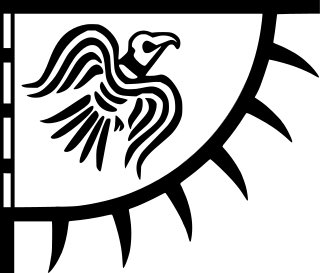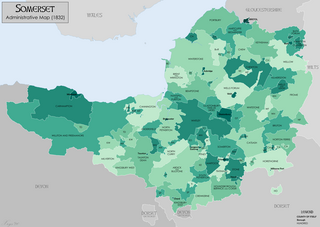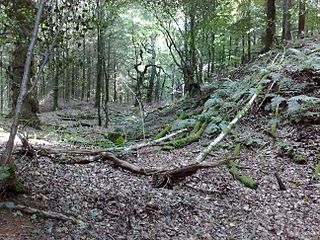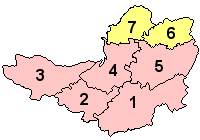
Wessex was an Anglo-Saxon kingdom in the south of Great Britain, from 519 until England was unified by Æthelstan in 927.

Edmund Ironside was King of England from 23 April to 30 November 1016. He was the son of King Æthelred the Unready and his first wife, Ælfgifu of York. Edmund's reign was marred by a war he had inherited from his father; his cognomen "Ironside" was given to him "because of his valour" in resisting the Danish invasion led by Cnut the Great.

Wiltshire is a county in South West England with an area of 3,485 km2. It is landlocked and borders the counties of Dorset, Somerset, Hampshire, Gloucestershire, Oxfordshire and Berkshire. The county town was originally Wilton, after which the county is named, but Wiltshire Council is now based in the county town of Trowbridge. Within the county's boundary are two unitary authority areas, Wiltshire and Swindon, governed respectively by Wiltshire Council and Swindon Borough Council.

Somerset is a county in South West England which borders Gloucestershire and Bristol to the north, Wiltshire to the east, Dorset to the south-east and Devon to the south-west. It is bounded to the north and west by the Severn Estuary and the Bristol Channel, its coastline facing southeastern Wales. Its traditional border with Gloucestershire is the River Avon. Somerset's county town is Taunton.

South West England is one of nine official regions of England. It is the largest in area, covering 9,200 square miles (23,800 km2), and consists of the counties of Bristol, Cornwall, Dorset, Devon, Gloucestershire, Somerset, and Wiltshire, as well as the Isles of Scilly. Five million people live in South West England.

The Danelaw, as recorded in the Anglo-Saxon Chronicle, is a historical name given to the part of England in which the laws of the Danes held sway and dominated those of the Anglo-Saxons. Danelaw contrasts with West Saxon law and Mercian law. The term is first recorded in the early 11th century as Dena lage. Modern historians have extended the term to a geographical designation. The areas that constituted the Danelaw lie in northern and eastern England.

At the Battle of Edington, an army of the Anglo-Saxon kingdom of Wessex under Alfred the Great defeated the Great Heathen Army led by Guthrum on a date between 6 and 12 May AD 878, resulting in the Treaty of Wedmore later the same year. Primary sources locate the battle at "Ethandun" or "Ethandune", and until a scholarly consensus linked its location with the present-day Edington in Wiltshire it was known as the Battle of Ethandun, a name which continues to be used.

Bath and North East Somerset is the district of the unitary authority of Bath and North East Somerset Council that was created on 1 April 1996 following the abolition of the county of Avon. It is part of the ceremonial county of Somerset.

Glastonbury Abbey was a monastery in Glastonbury, Somerset, England. Its ruins, a grade I listed building and scheduled ancient monument, are open as a visitor attraction.

Somerset is a historic county in the south west of England. There is evidence of human occupation since prehistoric times with hand axes and flint points from the Palaeolithic and Mesolithic eras, and a range of burial mounds, hill forts and other artefacts dating from the Neolithic, Bronze and Iron Ages. The oldest dated human road work in Great Britain is the Sweet Track, constructed across the Somerset Levels with wooden planks in the 39th century BCE.
The Battle of Cynwit, also spelt Cynuit, was a battle between West Saxons and Vikings in 878 at a fort which Asser calls Cynwit. The location of the battle is uncertain. Possible sites include Cannington Hill, near Cannington, Somerset; and Countisbury Hill, near Countisbury, Devon.

The Battle of Peonnum was fought about AD 660 between the West Saxons under Cenwalh and the Britons of what is now Somerset in England. It was a decisive victory for the Saxons, who gained control of Somerset as far west as the River Parrett. The location of the battle is uncertain.

Taunton Castle is a castle built to defend the town of Taunton, Somerset, England. It has origins in the Anglo Saxon period and was later the site of a priory. The Normans then built a stone structured castle, which belonged to the Bishops of Winchester. The current heavily reconstructed buildings are the inner ward, which now houses the Museum of Somerset and the Somerset Military Museum. The building was designated a grade I listed building in 1952.
Events from the 9th century in England.

The Grade I listed buildings in Somerset, England, demonstrate the history and diversity of its architecture. The ceremonial county of Somerset consists of a non-metropolitan county, administered by Somerset County Council, which is divided into five districts, and two unitary authorities. The districts of Somerset are West Somerset, South Somerset, Taunton Deane, Mendip and Sedgemoor. The two administratively independent unitary authorities, which were established on 1 April 1996 following the breakup of the county of Avon, are North Somerset and Bath and North East Somerset. These unitary authorities include areas that were once part of Somerset before the creation of Avon in 1974.

The earliest known infrastructure for transport in Somerset is a series of wooden trackways laid across the Somerset Levels, an area of low-lying marshy ground. To the west of this district lies the Bristol Channel, while the other boundaries of the county of Somerset are along chains of hills that were once exploited for their mineral deposits. These natural features have all influenced the evolution of the transport network. Roads and railways either followed the hills, or needed causeways to cross the Levels. Harbours were developed, rivers improved, and linked to sources of traffic by canals. Railways were constructed throughout the area, influenced by the needs of the city of Bristol, which lies just to the north of Somerset, and to link the ports of the far south-west with the rest of England.
The Sumorsaete were an Anglo-Saxon group living in what is now Somerset, presumably around the town of Somerton. They are evidently the source of the county's name. The group may have been established as early as 577, when the Saxons conquered part of the area from the Britons, but they are not mentioned by name until 845. They may have been related to the obscure Glastening or Glestinga, who may be the source of the name Glastonbury.

There are over 670 scheduled monuments in the ceremonial county of Somerset in South West England. The county consists of a non-metropolitan county, administered by Somerset County Council, which is divided into five districts, and two unitary authorities. The districts of Somerset are West Somerset, South Somerset, Taunton Deane, Mendip and Sedgemoor. The two administratively independent unitary authorities, which were established on 1 April 1996 following the breakup of the county of Avon, are North Somerset and Bath and North East Somerset. These unitary authorities include areas that were once part of Somerset before the creation of Avon in 1974.
Odda, also known as Oddune, was a ninth-century ealdorman of Devon. He is known for his victory at the Battle of Cynwit in 878, where his West Saxon forces defeated a Viking army led by Ubba, brother of the Viking chiefs Ivar the Boneless and Halfdan Ragnarsson.